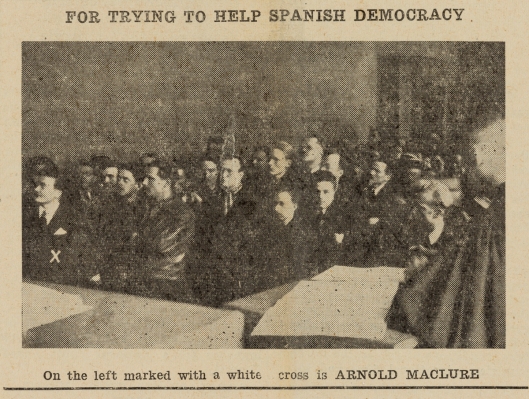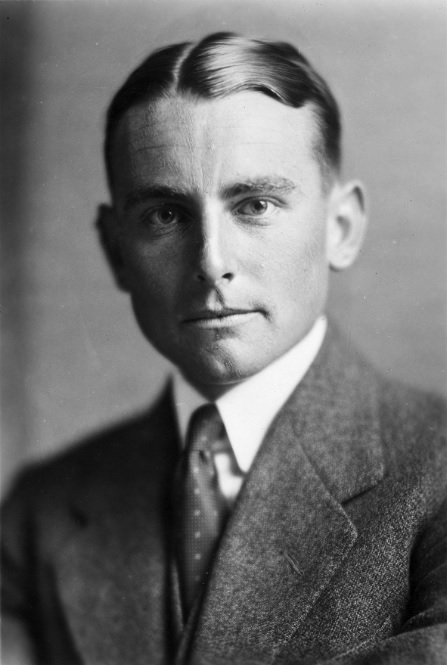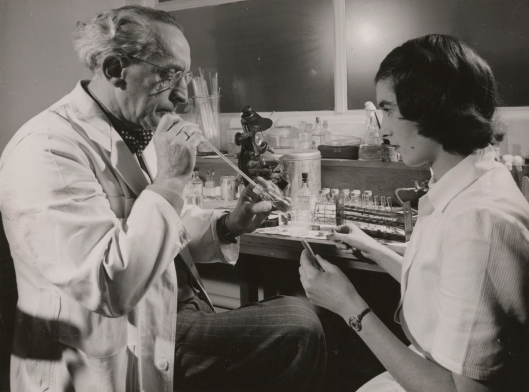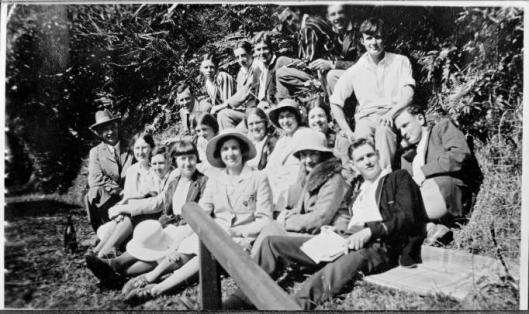Tags
1870s, 1880s, 1890s, 1910s, 1920s, 1950s, 1960s, 1970s, 1990s, 2000s, arts fellows, English, linguistics, writers
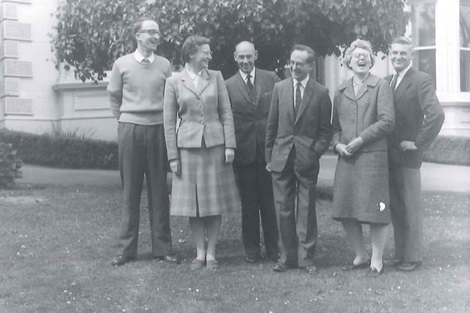
The English Department staff outside their premises in Cameron House, a grand two-storeyed family home on Leith Street (later knocked down to make way for UniCol), in 1961. Until tutorials were introduced, the department fitted into a small room in the Clocktower Building. From left: Keith Maslen, Lenore Harty, Gregor Cameron, Alan Horsman, Margaret Dalziel and Bob Robertson. Dalziel later became Otago’s first woman humanities professor and Pro-Vice-Chancellor. Image courtesy of the Department of English and Linguistics.
English is one of Otago’s founding subjects and has always been one of its most popular. In 1871 George Sale, the Cambridge-educated classics professor, taught an English class of 22, though it was an unfamiliar task for him. At his inaugural lecture Sale commented that neither Cambridge nor Oxford had a professor of English so he looked to the Scottish universities for inspiration; he concluded that their teaching encouraged ‘that very vice which it should be the especial object of a University to eradicate – shallowness and superficiality. He was therefore compelled to strike out a line for himself’. 1871 English students started the session with Chaucer, plunging straight into Middle English. When the class progressed to ‘the more modern language’ of Shakespeare’s sonnets after its ‘thorough and profitable perusal of the Canterbury Tales’, it earned a report in the ODT; perhaps the reporter was a student.
In 1881 Sale handed his English classes over to John Mainwaring Brown, another Cambridge graduate, appointed to a new chair of English, constitutional history (for law students) and political economy (economics). Brown was popular – and less intimidating than Sale – but his career ended tragically when he disappeared during a tramping expedition in Fiordland at the end of 1888. With the arrival of Thomas Gilray in 1890, Otago had its first dedicated professor of English; a period of remarkable stability followed as the chair was held by just two men, both Scots, for three decades each.
Gilray was highly organised but not the most engaging lecturer: Muriel May, a student of the 1910s, recalled that he ‘taught by dictating at a relentless pace to his benches of scribbling students in the Lower Oliver classroom …. at the prearranged dates we regurgitated. There were no seminars, no discussions, originality was not fostered nor were personal opinions encouraged’. It didn’t help that he was bound by a national syllabus, with exam papers marked by strangers in the UK. Gilray’s death came as a shock: he collapsed while reading the lesson at the university’s jubilee church service, held in Knox Church in 1920. His successor, Herbert Ramsay, was ‘one of the university’s best lecturers’ and students delighted in his thoughts on Shakespeare. The course and teaching methods remained conservative. Ramsay boasted in a 1950 valedictory speech to the University Council that he never asked them for more staff. He and long-serving lecturer Gregor Cameron did all the teaching, with one additional junior lecturer from the late 1940s; they remained committed to the Scottish lecture-only system. John Greig, a Scot who taught in England, the US and South Africa, introduced radical changes as professor from 1952 to 1956. No fan of the conventional lecture, Greig introduced group tutorials; as a consequence, English’s academic staff jumped from three to seven, plus part-time tutors. He also modernised the curriculum, adding works by twentieth-century authors (Sean O’Casey, T.S. Eliot, Virginia Woolf) and New Zealand poetry and short stories.
The inclusion of New Zealand literature in university courses was controversial. As Otago lecturer Robert Robertson explained, it was generally taught as ‘a dutiful recognition’ that first-year students should be aware of New Zealand poetry. There was an element of colonial cringe, but teaching local literature was hard work for staff, who had only ‘partial bibliographies, few collected works, no collected letters, not a standard biography, incomplete histories only and a scattered body of occasional criticism of varying merit’. Alan Horsman, a New Zealander who studied and taught in England, arrived as Otago’s new English professor in 1957. He recalls it as a significant year, with the publication of Janet Frame’s Owls Do Cry and Ian Cross’s The God Boy, novels which stood comparison with the best English writing; there was already poetry ‘of top quality’. He was reluctant, though, to introduce a paper devoted to New Zealand literature. Lawrence Jones, an American who arrived as lecturer in 1964, found Otago students responded more enthusiastically to Janet Frame than Thomas Hardy, and his research interests shifted to New Zealand literature. In 1977, in response to student demand, an honours paper fully devoted to New Zealand work was introduced; further undergrad courses followed and research expanded.

Burns Fellows received a year’s salary, a room in the English Department and complete freedom to write. Not all writers found the year easy, but others thrived during their first opportunity to write full-time. Cilla McQueen, the 1985 and 1986 Burns Fellow, is photographed in contemplative mood in the fellow’s office at the 50th anniversary celebrations of the fellowship in 2008. The office was then occupied by Sue Wootton. Image courtesy of the English and Linguistics Department.
Cross and Frame were both recipients of the university’s Robert Burns Fellowship for writers, commenced in 1959. In addition to providing some of the country’s greatest writers an opportunity to create without financial stress for a year, the fellowship was important for the English Department, which hosted the fellows. Staff and students interacted with them: ‘It was a very good thing for the department to have practising writers around, available to be talked with’, says Horsman. Some, like 1966 and 1967 Burns Fellow James K. Baxter, participated in classes. He ‘would come to a class occasionally and make his experience available. He would speak to the class about prosody in a way which, from a practising poet, was authoritative’, recalls Horsman.
Otago ventured into linguistics in the 1970s and in 1990 its small programme moved into the English Department; from 1994 students could major in linguistics. Another applied field which mushroomed in the 1990s was writing. It began when other departments expressed concern over students’ communication skills. In 1993 English introduced a paper on ‘the fundamentals of effective speaking and writing’; it was designed for health science students, for whom it was compulsory until 2006, but other departments at various times recommended or required it and other students also found it useful. It morphed into ‘English for university purposes’. Later the department expanded beyond the remedial or introductory with courses in advanced writing, writing for the professions and a creative writing paper in poetry.

Greg Waite (at centre, with beard), discussing the Textbase of Early Tudor English Project with participants at a conference in 1990. Waite and Alistair Fox started this early example of digital humanities in 1984, producing a machine-readable corpus of early Tudor literary texts, with particular focus on poetry. The project was largely completed by the late 1990s and transferred online in 2002. Image courtesy of the English and Linguistics Department.
Two new endowed chairs expanded the department in a Celtic direction. In 2006 Peter Kuch was appointed as Eamon Cleary Professor of Irish Studies and in 2009 Liam McIlvanney became Stuart Professor of Scottish Studies. Both are literary scholars (and McIlvanney has a sideline as a crime writer). They provided intellectual stimulation to an English Department already a mix of the old and the new: along with esteemed scholars of historic writers (for instance, Jane Austen expert Jocelyn Harris) it employed up-and-comers with interests in digital literature, post-colonial literature and the avant-garde, among other fields. Its writing programme was also a ‘sizeable operation’. Meanwhile, Middle English, Old English and Old Norse were still spake here. Rick McGregor, a 1992 PhD graduate, came from Auckland to research the use of Icelandic sagas by a modern Swedish writer because Old Norse remained on offer in the south; Otago’s blend of conservatism and innovation has distinct advantages!
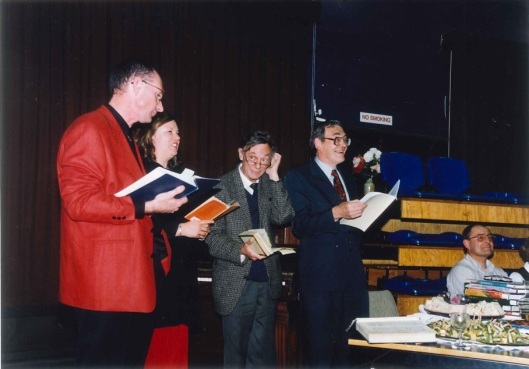
Chaucer, the English Department’s first text, has never gone out of fashion. Giving a Chaucer reading at Colin Gibson’s retirement function in 1998 are, from left: Greg Waite, Nicola Cummins, Bill Dean and Colin Gibson. Image courtesy of the English and Linguistics Department.

